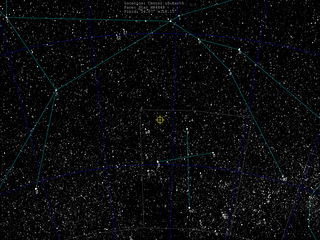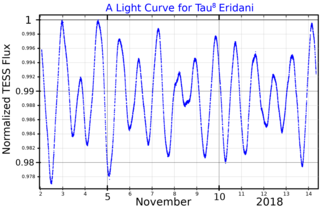Related Research Articles

Xi1 Sagittarii (ξ1 Sagittarii) is a solitary, blue-white hued star in the zodiac constellation of Sagittarius. It is visible to the naked eye with an apparent visual magnitude of +5.06. Based upon a small annual parallax shift of 1.58 mas as seen from Earth, this system is located roughly 2,100 light years from the Sun.

Rho2 Sagittarii (ρ2 Sagittarii) is a star in the zodiac constellation of Sagittarius. With an apparent visual magnitude of +5.87, it is near the lower limit of stars that can be seen with the naked eye. Based upon an annual parallax shift of 9.82 mas as seen from Earth, it is located around 330 light years from the Sun.

Theta2 Sagittarii, Latinized from θ2 Sagittarii, is a solitary star in the zodiac constellation of Sagittarius. It is faintly visible to the naked eye with an apparent visual magnitude of +5.30. The star is progressing in the general direction of the Sun with a radial velocity of −17.60 km/s. Based upon an annual parallax shift of 20.62 mas as seen from Earth, it is located around 158 light years from the Sun. The star is drifting closer with a radial velocity of −17.6 km/s.

Chi3 Sagittarii (χ3 Sagittarii) is a solitary, orange-hued star in the zodiac constellation of Sagittarius. It is faintly visible to the naked eye with an apparent visual magnitude of +5.45. Based upon an annual parallax shift of 6.53 mas as seen from Earth, it is located roughly 500 light years from the Sun. It is receding from the Earth with a radial velocity of 39.6 km/s.
ι2 Scorpii, Latinised as Iota2 Scorpii, is a single star in tail of the zodiac constellation of Scorpius. It has an apparent visual magnitude of +4.82, and is visible to the naked eye. Because of parallax measurement errors, the distance to this star is only approximately known: it lies around 2,500 light years away from the Sun. It has a visual companion, a magnitude 11.0 star at an angular separation of 31.60 arcseconds along a position angle of 36°, as of 2000.
Lambda Canis Majoris is a solitary, blue-white hued star in the constellation Canis Major. Lambda CMa is visible to the naked eye with an apparent visual magnitude of +4.48. Based upon an annual parallax shift of 7.70 mas as seen from Earth, this star is located about 424 light years from the Sun. At that distance, the visual magnitude is diminished by an extinction of 0.14 due to interstellar dust.
N Carinae is a single star in the constellation Carina, just to the northeast of the prominent star Canopus. This object has a white hue and is faintly visible to the naked eye with an apparent visual magnitude of 4.35. Based on parallax, it is located at a distance of approximately 1,360 light years from the Sun. It has an absolute magnitude of −3.75, and is drifting further away with a radial velocity of +22.5 km/s.
G Centauri is a single star in the southern constellation of Centaurus. It is visible to the naked eye as a faint, blue-white hued star with an apparent visual magnitude of +4.82. This object is located approximately 450 light years from the Sun, based on parallax. It is a member of the Lower Centaurus–Crux group of the Scorpius–Centaurus association, with the former having an age of about 17 million years.
HD 75063 is a single star in the southern constellation of Vela. It has the Bayer designation of a Velorum, while HD 75063 is the identifier from the Henry Draper Catalogue. This is a naked-eye star with an apparent visual magnitude of 3.87 and has a white hue. The star is located at a distance of approximately 1,900 light-years from the Sun based on parallax measurements and has an absolute magnitude of −4.89. It is drifting further away with a radial velocity of +23 km/s.
HD 156091 is a double star in the southern constellation of Ara. The primary is a sixth magnitude giant star with stronger than normal lines of carbon, nitrogen, and barium in its spectrum. The companion is a 13th magnitude star at an angular separation of 27.4″ along a position angle of 275°, as of 2000.

HD 110956 is a single star in the southern constellation of Crux. It is faintly visible to the naked eye with an apparent visual magnitude of 4.62. The distance to this star is approximately 385 light years based on parallax and it is drifting further away with a radial velocity of 15.5 km/s. It is a probable member of the Lower Centaurus–Crux subgroup of the Scorpius–Centaurus association.

Tau8 Eridani, Latinized from τ8 Eridani, is a binary star system in the constellation Eridanus. It is visible to the naked eye with a combined apparent visual magnitude of 4.65. The distance to this system can be estimated via the parallax method, yielding a value of around 380 light years.
Omega Hydrae, Latinised from ω Hydrae, is a golden-hued star in the equatorial constellation of Hydra, located to the west-southwest of the brighter star Zeta Hydrae. Based upon an annual parallax shift of just 3.64 mas as seen from Earth, it is located roughly 900 light-years from the Sun. It is faintly visible to the naked eye with an apparent visual magnitude of 5.00.
η Lupi, often Latinised as Eta Lupi, is a probable triple star system in the southern constellation of Lupus. It is visible to the naked eye with an apparent visual magnitude of 3.41. Based upon an annual parallax shift of 27.80 mas as seen from Earth, it is located around 136 parsecs (440 ly) distant from the Sun. It is a member of the Upper Centaurus–Lupus subgroup of the nearby Sco OB2 association.
Zeta Monocerotis, Latinized from ζ Monocerotis, is a single, yellow-hued star in the constellation Monoceros. It has an apparent visual magnitude of 4.33, which is bright enough to be visible to the naked eye. The annual parallax shift as measured during the Hipparcos mission is 3.08 milliarcseconds, which provides a rough distance estimate of 1,060 light years. It is moving away from the Sun with a radial velocity of +30 km/s.

HD 70555 is a class K2.5II-III star in the constellation Puppis. Its apparent magnitude is 4.83 and it is approximately 1,010 light years away based on parallax.

52 Sagittarii is a binary star system in the southern constellation of Sagittarius. It has the Bayer designation h2 Sagittarii, while 52 Sagittarii is the Flamsteed designation. This system is visible to the naked eye as a faint, blue-white hued point of light with an apparent visual magnitude of 4.59. It is located approximately 190 light years away based on parallax, but is drifting closer with a radial velocity of −19 km/s.

HD 167818 is a class K3II star in the constellation Sagittarius. Its apparent magnitude is 4.66 and it is approximately 760 light years away based on parallax.

21 Sagittarii is a binary star system in the southern zodiac constellation of Sagittarius. It is visible to the naked eye as a faint point of light with a combined apparent visual magnitude of 4.81. The system is located approximately 410 light years away from the Sun based on parallax. It is moving closer to the Earth with a heliocentric radial velocity of −11.80 km/s.
Omega2 Tauri is a solitary, white hued star in the zodiac constellation of Taurus. It has an apparent visual magnitude of +4.9, which is bright enough to be seen with the naked eye at night. The distance to this system, as determined using an annual parallax shift of 34.55 mas as seen from the Earth, is about 94 light years.
References
- 1 2 3 4 5 6 van Leeuwen, F. (2007), "Validation of the new Hipparcos reduction", Astronomy and Astrophysics, 474 (2): 653–664, arXiv: 0708.1752 , Bibcode:2007A&A...474..653V, doi:10.1051/0004-6361:20078357, S2CID 18759600.
- 1 2 3 4 Gontcharov, G. A. (2006), "Pulkovo Compilation of Radial Velocities for 35 495 Hipparcos stars in a common system", Astronomy Letters, 32 (11): 759–771, arXiv: 1606.08053 , Bibcode:2006AstL...32..759G, doi:10.1134/S1063773706110065, S2CID 119231169.
- 1 2 Houk, Nancy; Smith-Moore, M. (1978), Michigan catalogue of two-dimensional spectral types for the HD stars, vol. 4, Ann Arbor: Dept. of Astronomy, University of Michigan, Bibcode:1988mcts.book.....H.
- ↑ Anderson, E.; Francis, Ch. (2012), "XHIP: An extended hipparcos compilation", Astronomy Letters, 38 (5): 331, arXiv: 1108.4971 , Bibcode:2012AstL...38..331A, doi:10.1134/S1063773712050015, S2CID 119257644.
- 1 2 3 4 5 Tetzlaff, N.; Neuhäuser, R.; Hohle, M. M. (January 2011), "A catalogue of young runaway Hipparcos stars within 3 kpc from the Sun", Monthly Notices of the Royal Astronomical Society , 410 (1): 190–200, arXiv: 1007.4883 , Bibcode:2011MNRAS.410..190T, doi: 10.1111/j.1365-2966.2010.17434.x , S2CID 118629873.
- 1 2 3 McDonald, I.; et al. (2012), "Fundamental parameters and infrared excesses of Hipparcos stars", Monthly Notices of the Royal Astronomical Society, 427 (1): 343–357, arXiv: 1208.2037 , Bibcode:2012MNRAS.427..343M, doi: 10.1111/j.1365-2966.2012.21873.x , S2CID 118665352.
- ↑ "6 Sgr". SIMBAD . Centre de données astronomiques de Strasbourg . Retrieved 2018-03-14.
- ↑ Plets, H.; et al. (July 1997), "Giants with infrared excess", Astronomy and Astrophysics, 323: 513–523, Bibcode:1997A&A...323..513P.